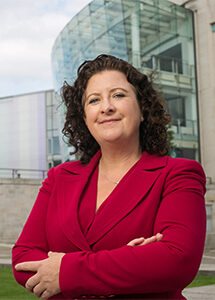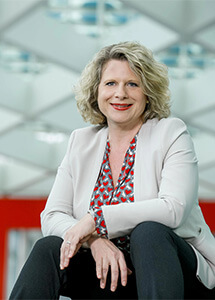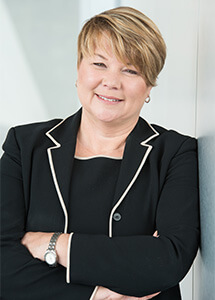Annual event offers a look at the conference centre/association relationship and at the trends centres are seeing.
Taking part in a congress whose delegates are the people associations deal with when organising their events is always eye opening. AIPC represents a global network of more than 185 conference centres in 60 countries. And at the AIPC Annual Conference in London in July, Boardroom gained insights on the close relationship between venues and associations. Catherine Toolan, managing director of the ICC (International Convention Centre) Belfast (formerly Belfast Waterfront); Martina Candillo, director of congresses and events at Messe Wien; and Julianne Jammers, managing director of the SwissTech Convention Center in Lausanne, are all members of AIPC and also have associations as clients.
By Rémi Dévé
Does being a member of AIPC and a delegate of the AIPC Annual Conference help you understand better how associations operate in general?

Catherine Toolan
Catherine Toolan: Absolutely. My team and I benefit hugely from the insights that being a member of AIPC yields. The geographic spread of global members enables interesting discussions around the differences that are present within the various markets. AIPC membership allows member bodies to look conversely at conventions so that we have a greater appreciation of the intricacies association managers are faced with and how these may change. As a member of AIPC and as a delegate in general, I see the challenge of providing content in an engaging and diverse way. Whilst listening to presentations and expert speakers is critical, we must find easier ways to (make) an overall conference day be more energising, engaging, and collaborative.
Martina Candillo: The AIPC Annual Conference is a great platform to learn about new industry trends and how they relate to venues. On the other end of the spectrum, associations have always put science and education in the centre of their meetings. This has not changed; however, the profiles of their attendees have changed. Millennials are looking for more than just attending a congress — they value a multi-faceted experience. They are looking for a personal experience and therefore associations have to know the DNA of their attendees very well to cater to their needs. Being a member of AIPC and attending its annual conference is always enlightening as to what kind of added value(s) an association can bring to its members.
Julianne Jammers: AIPC is all about conference centre management: its educational programmes, benchmarking initiatives, and information-gathering efforts are essential for conference centre managers. Combined with our ICCA membership, it provides great insights on associations’ work and what their specific needs are. This enables conference centers to adjust their strategies to deliver to this significant client in the event business, even if there remain opportunities to strengthen this understanding from both organisations — which actually complement each other — to improve the end customer experience.
What do you think are the latest trends in association meetings?
Toolan: I feel that association meetings are incorporating more and more digital elements and tactics to encourage delegate engagement. Many delegates are now familiar and comfortable with technologies such as voting buttons and live social media streams so innovative solutions are always being sought for associations to provide the most immersive and holistic approach to meetings for attendees. Whilst many associations were previously heavily focused on plenary sessions, there is also a trend now towards facilitated learning through networking and peer-to-peer engagement. Powerful thought leaders as keynote speakers are still a critical element in attracting conference delegates but balanced with more networking and collaboration. We’re also witnessing a bigger focus on data and analytics using digital tools, in particular accurate measurement of footfall via RFIDs, beacons, and heat mapping. This helps associations sell future exhibition space or indeed can help create measurable dynamic pricing models for selling future key exhibition space.

Martina Candillo
Candillo: At the moment, I believe they all relate to how personalised the experience of the delegate can be, starting with a well-designed website, conference app, matchmaking software, interactive meeting formats, networking spaces, seamless Wi-Fi, and, of course, diverse food and beverage options.
Jammers: Like most businesses, associations are confronted with challenges related to growth, cost-management, return on investment, communication, client-member management amongst others. And they want to deliver events to their members that are engaging, memorable, impactful, and cost-effective. To me, we should not be talking about trends, but about a reality that organisations are confronted with on a daily basis.
Has the way you work as a conference centre with associations changed over the years? How can you bring value to their work?
Toolan: Our venue has over 20 years’ experience, so solid foundations have been laid upon which our team can plan and deliver conferences that exceed the objectives of the association. However, we have to remain competitive in an increasingly penetrated market. This can be clearly illustrated through the example of our brand reposition from Belfast Waterfront to ICC Belfast, which officially (came) into effect in October. One of the practical ways ICC Belfast is well equipped to add significant value to association events is through the delivery of a bespoke integrated communications plan, benefitting both the client and ICC Belfast. A communications plan was developed for a recent very large medical congress and was highly successful in terms of media reach, which was valued at £1.8m for the five-day event and was provided at no additional cost to the client.
Candillo: Of course, we have adapted to changing needs in order to better serve our customers. There are new technologies that can capture and analyze the full journey of every single visitor, helping congress planners design their space layout more efficiently. Messe Wien is partnering with a company who is offering this kind of tool to our clients. We have also just been accredited as a Healthy Venue by the World Obesity Federation — the first and only venue in Austria. This means that we are committed to providing a venue that promotes activity and healthy eating — all things that are more and more valued by delegates. Due to the versatility and flexibility of the Messe Wien we can also easily adapt to changing layouts — an important asset when you consider that association congresses are booked many years in advance when it is impossible to know if and how the space needs will change.

Julianne Jammers
Jammers: I believe that conference centres have become much more complete in their approach to working with associations. We need to really understand their needs and the constraints, as the venue is a relatively small part of the overall event both in terms of cost and in terms of operations. We work either directly with our clients or in very close contact with a DMC or our convention bureau, to accompany them throughout their event journey, with particular attention to the choices related to location. We prefer the more pro-active role that allows us to act as a partner and not just a supplier.
This article was contributed by Boardroom.


